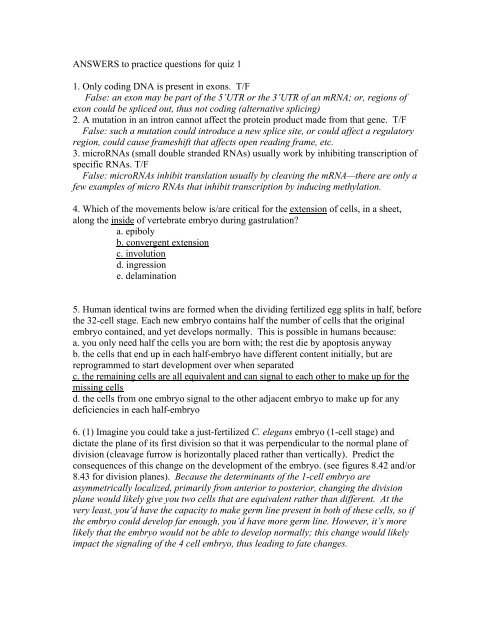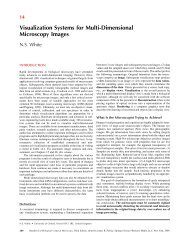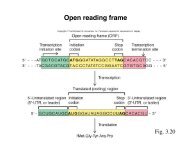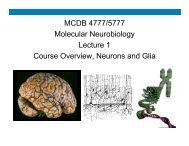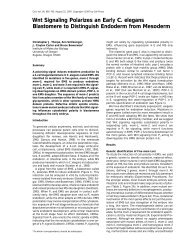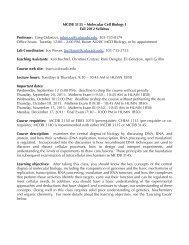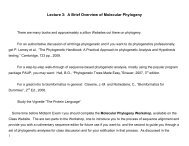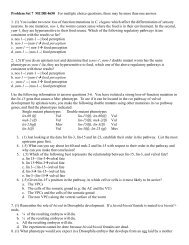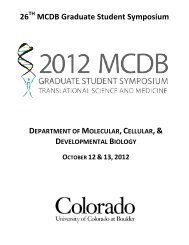ANSWERS to practice questions for quiz 1 1. Only coding DNA is ...
ANSWERS to practice questions for quiz 1 1. Only coding DNA is ...
ANSWERS to practice questions for quiz 1 1. Only coding DNA is ...
Create successful ePaper yourself
Turn your PDF publications into a flip-book with our unique Google optimized e-Paper software.
<strong>ANSWERS</strong> <strong>to</strong> <strong>practice</strong> <strong>questions</strong> <strong>for</strong> <strong>quiz</strong> 1<br />
<strong>1.</strong> <strong>Only</strong> <strong>coding</strong> <strong>DNA</strong> <strong>is</strong> present in exons. T/F<br />
False: an exon may be part of the 5’UTR or the 3’UTR of an mRNA; or, regions of<br />
exon could be spliced out, thus not <strong>coding</strong> (alternative splicing)<br />
2. A mutation in an intron cannot affect the protein product made from that gene. T/F<br />
False: such a mutation could introduce a new splice site, or could affect a regula<strong>to</strong>ry<br />
region, could cause frameshift that affects open reading frame, etc.<br />
3. microRNAs (small double stranded RNAs) usually work by inhibiting transcription of<br />
specific RNAs. T/F<br />
False: microRNAs inhibit translation usually by cleaving the mRNA—there are only a<br />
few examples of micro RNAs that inhibit transcription by inducing methylation.<br />
4. Which of the movements below <strong>is</strong>/are critical <strong>for</strong> the extension of cells, in a sheet,<br />
along the inside of vertebrate embryo during gastrulation?<br />
a. epiboly<br />
b. convergent extension<br />
c. involution<br />
d. ingression<br />
e. delamination<br />
5. Human identical twins are <strong>for</strong>med when the dividing fertilized egg splits in half, be<strong>for</strong>e<br />
the 32-cell stage. Each new embryo contains half the number of cells that the original<br />
embryo contained, and yet develops normally. Th<strong>is</strong> <strong>is</strong> possible in humans because:<br />
a. you only need half the cells you are born with; the rest die by apop<strong>to</strong>s<strong>is</strong> anyway<br />
b. the cells that end up in each half-embryo have different content initially, but are<br />
reprogrammed <strong>to</strong> start development over when separated<br />
c. the remaining cells are all equivalent and can signal <strong>to</strong> each other <strong>to</strong> make up <strong>for</strong> the<br />
m<strong>is</strong>sing cells<br />
d. the cells from one embryo signal <strong>to</strong> the other adjacent embryo <strong>to</strong> make up <strong>for</strong> any<br />
deficiencies in each half-embryo<br />
6. (1) Imagine you could take a just-fertilized C. elegans embryo (1-cell stage) and<br />
dictate the plane of its first div<strong>is</strong>ion so that it was perpendicular <strong>to</strong> the normal plane of<br />
div<strong>is</strong>ion (cleavage furrow <strong>is</strong> horizontally placed rather than vertically). Predict the<br />
consequences of th<strong>is</strong> change on the development of the embryo. (see figures 8.42 and/or<br />
8.43 <strong>for</strong> div<strong>is</strong>ion planes). Because the determinants of the 1-cell embryo are<br />
asymmetrically localized, primarily from anterior <strong>to</strong> posterior, changing the div<strong>is</strong>ion<br />
plane would likely give you two cells that are equivalent rather than different. At the<br />
very least, you’d have the capacity <strong>to</strong> make germ line present in both of these cells, so if<br />
the embryo could develop far enough, you’d have more germ line. However, it’s more<br />
likely that the embryo would not be able <strong>to</strong> develop normally; th<strong>is</strong> change would likely<br />
impact the signaling of the 4 cell embryo, thus leading <strong>to</strong> fate changes.
7. Convergent extension <strong>is</strong> an important type of movement during morphogenes<strong>is</strong>.<br />
Briefly explain how th<strong>is</strong> type of cell rearrangement might be important <strong>for</strong> a developing<br />
embryo. Convergent extension <strong>is</strong> particularly important <strong>for</strong> the spread of no<strong>to</strong>chord<br />
cells, as they have <strong>to</strong> extend a long ways from the dorsal blas<strong>to</strong>pore lip all the way up <strong>to</strong><br />
the future head. Basically, any time you need a chunk of cells <strong>to</strong> line up in a long orderly<br />
row, convergent extension <strong>is</strong> the way <strong>to</strong> go.<br />
8. You decide <strong>to</strong> investigate whether some known signaling pathways might be involved<br />
in determining ventral vs. dorsal mesoderm fate in Xenopus. You use antibody labeling<br />
<strong>to</strong> observe the localization of two different signaling ligands, Shh and a TGFβ family<br />
member (BMP4), in the early blastula stage. There are many different possibilities <strong>for</strong><br />
how these two ligands might be localized within the embryo. A. Predict their localization<br />
if mesoderm <strong>for</strong>ms due <strong>to</strong> a morphogen gradient or gradients. B. Predict their<br />
localization if two different kinds of mesoderm require different signals <strong>to</strong> be specified<br />
îf they act as a morphogen, each molecule must be present in a gradient across the<br />
embryo, and specify fate dependent on concentration. Thus, in th<strong>is</strong> case, you might see<br />
Shh gradient from low on the ventral side <strong>to</strong> high on the dorsal side, and BMP from high<br />
on the ventral side <strong>to</strong> low on the dorsal side.<br />
9.The polypeptide hormone prolactin stimulates milk production in female mammary<br />
glands. When the hormone <strong>is</strong> present, production of the milk protein casein increases,<br />
largely because the casein mRNA degrades much more slowly than it does when<br />
prolactin <strong>is</strong> absent. The hormone does not enter the mammary gland cells, and the<br />
degradation rates of other mRNAs are not affected. From your knowledge of signaling,<br />
predict the steps in a pathway by which the hormone could cause an increase in the<br />
stability of th<strong>is</strong> specific mRNA.<br />
Prolactin could<br />
<strong>1.</strong> act directly as a transcription fac<strong>to</strong>r (some steroid hormones can be transported<br />
directly <strong>to</strong> the nucleus –“nuclear hormone recep<strong>to</strong>rs”) <strong>to</strong> trigger casein<br />
production (prolactin doesn’t actually work th<strong>is</strong> way, but it <strong>is</strong> a reasonable<br />
hypothes<strong>is</strong>)<br />
2. act as signaling ligand (bind <strong>to</strong> a recep<strong>to</strong>r) and through signaling cascade,<br />
activate transcription of casein<br />
3. prevent degradation of casein by binding <strong>to</strong> whatever normally degrades It after it<br />
has been translated<br />
4. activate transcription of another fac<strong>to</strong>r which could bind <strong>to</strong> the 3’UTR of the<br />
casein mRNA, allowing it <strong>to</strong> stick around longer and thus produce more protein.


